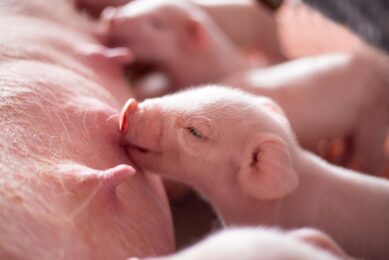Journées: Criteria to assess piglet maturity
Lallemand Animal Nutrition presented a study on piglet maturity during this week’s Porcine Research Days in Paris (Journées de la Recherche Porcine 2010), defining a set of criteria to assess piglet maturity at birth.
The tool can help farmers evaluate future performance of ©newborn piglets and assist in reducing their related costs thanks to a more fluid litter management.
Hyper-prolific sow
In recent years, the race to©the hyper-prolific sow has given rise to important litter heterogeneity at birth. Heterogeneity which later affects zootechnical performance: mortality, daily weight gain, live weight at weaning… Nevertheless, piglet weight at birth by itself is not discriminating enough to predict the animal’s productive life. Its level of maturity, linked to its intra-uterine development, appears as a more accurate prediction tool to evaluate piglet survival chances and weaning weight.
Audrey Sacy, who conducted the study, explained: “Piglet immaturity is largely underestimated, while it plays a great part in litter heterogeneity. It does affect survival in maternity (in our study, immature piglets survival attained no more than 62% vs. 89% for the mature piglets). It also causes growth retardation: average live weight at weaning was 4.7 kg for the immature piglets vs. 5.7 kg for the mature ones. Far from being an isolated phenomenon, immaturity affects all sows at every birth rank. In our study, 11% of the live born piglets were concerned. This can go up to 25% for older sows.”
Monitoring pigs
The study presented in Paris was conducted in 2008 at a 400-sow farm in Brittany, France. In total, more that 900 piglets were monitored from birth to weaning.
This study provides pig farmers a©new tool made of a set of simple criteria aimed at identifying immature piglets at birth:
• Morphological criteria: immature piglets are generally lighter, with a big oval head, a straight, ‘dolphin-like’ forehead and bulging eyes, no skin folds characteristic of older piglets
• Behavioural criteria: immature piglets are usually found isolated from the other piglets, lying on their side, and show characteristic behavior: vocalize, contractions-stretches
Mature and immature piglets
These criteria have been validated by anatomic data: mature and immature piglets show significant differences in their vital organs weight ratios.
Considering the outcome of immature piglets at farm level as well as the associated costs (mortality, care, delay in building rotation), piglet maturity at birth is indeed an interesting criteria which could be evaluated on a regular basis at farm-level, but which could also be integrated into future sow genetic selection.
Related articles:
• Paris getting ready for Porcine Research Days (Jan 25, 2010)
• PICTURE©REPORT: Sow nutrition technical meeting: Denmark (Oct 29, 2009)
Related websites:
• Lallemand Animal Nutrition
• Porcine Research Days (Journées de la Recherche Porcine)











